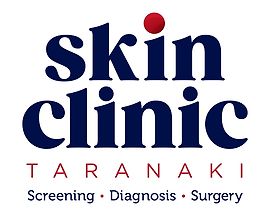Taranaki > Specialised Primary Health Care >
Skin Clinic Taranaki
Skin Cancer Service, General Surgery, Vein Treatment
Today
Description
Skin Clinic Taranaki is a small team of medical and nursing staff dedicated to providing you with the most up to date and effective methods of managing and treating skin cancer and sun damage.
We offer the following services:
- skin checks
- NAEVUS mole mapping
- total body imaging
- photodynamic therapy
- Varicose Vein treatment
and treat the following skin conditions:
Click on the link to see our list of Frequently Asked Questions (FAQs).
Staff
Registered Nurses/Clinical Staff
Gillian: Registered Nurse
Kim: Lead Registered Nurse
Kylie: Lead Registered Nurse
Hazel: Registered Nurse
Anne: Dermoscopist
Destinee: Health Care Assistant
Administration
Brooke: Receptionist
Amanda: Lead Receptionist
Kaysee: Receptionist
Meet the team here
Consultants
-

Mr Stephen Benson
Consultant Surgeon
Doctors
-

Dr Nelia Lourens
GP Skin Cancer Surgeon
-

Dr Duncan MacDonald
GP SNIP Surgeon
-

Dr Rob Pascoe
GP Skin Cancer Surgeon
-

Dr Greg Taylor
GP Skin Cancer Surgeon
-

Dr Geoff Tvrdeich
GP Skin Cancer Surgeon / Director
Ages
Child / Tamariki, Youth / Rangatahi, Adult / Pakeke, Older adult / Kaumātua
How do I access this service?
Referral Expectations
Your initial consultation is an important meeting to diagnose your skin condition and work in partnership with you to provide the most appropriate treatment options. Our staff use a dermoscope to view the moles or areas of concern you have.
Click here to see how long consultations take.
If you need surgery, we have a fully equipped operating theatre on the premises where your doctor will perform your procedure, sometimes on the same day as your consultation.
Fees and Charges Categorisation
Fees apply
Fees and Charges Description
Find out about our fees here
We are a Southern Cross Affiliated Provider and NIB First Choice member and all health insurance providers accepted.
Hours
| Mon – Fri | 8:00 AM – 5:00 PM |
|---|
Services Provided
New Zealand has a very high rate of skin cancer, when compared to other countries. The most common forms of skin cancer usually appear on areas of skin that have been over-exposed to the sun. Risk factors for developing skin cancer are: prolonged exposure to the sun; people with fair skin; and possibly over-exposure to UV light from sun beds. There are three main types of skin cancers: basal cell carcinoma, squamous cell carcinoma and malignant melanoma. Basal Cell Carcinoma (BCC) This is the most common type and is found on skin surfaces that are exposed to sun. A BCC remains localised and does not usually spread to other areas of the body. Sometimes BCC’s can ulcerate and scab so it is important not to mistake it for a sore. BCCs occur more commonly on the face, back of hands and back. They appear usually as small, red lumps that don’t heal and sometimes bleed or become itchy. They have the tendency to change in size and sometimes in colour. Treatment Often a BCC can be diagnosed just by its appearance. In other cases it will be removed totally and sent for examination and diagnosis, or a biopsy may be taken and just a sample sent for diagnosis. Removal of a BCC will require an appointment with a doctor or surgeon. It will be termed minor surgery and will require a local anaesthetic (numbing of the area) and possibly some stitches. A very small number of BCCs will require a general anaesthetic (you will sleep through the operation) for removal. Squamous Cell Carcinoma (SCC) This type of skin cancer also affects areas of the skin that have exposure to the sun. The most common area is the face, but an SCC can also affect other parts of the body and can spread to other parts of the body. The spreading (metastasising) can potentially be fatal if not successfully treated. A SCC usually begins as a keratosis that looks like an area of thickened scaly skin, it may then develop into a raised, hard lump which enlarges. SCCs can sometimes be painful. Often the edges are irregular and it can appear wart like, the colour can be reddish brown. Sometimes it can appear like a recurring ulcer that does not heal. All SCCs will need to be removed, because of their potential for spread. The removal and diagnosis is the same as for a BCC. Malignant Melanoma This is the most serious form of skin cancer. It can spread to other parts of the body and people can die from this disease. A melanoma usually starts as a pigmented growth on normal skin. They often, but not always, occur on areas that have high sun exposure. In some cases, a melanoma may develop from existing pigmented moles. What to look for: an existing mole that changes colour (it may be black, dark blue or even red and white) the colour pigment may be uneven the edges of the mole/freckle may be irregular and have a spreading edge the surface of the mole/freckle may be flaky/crusted and raised sudden growth of an existing or new mole/freckle inflammation and or itchiness surrounding an existing or new mole/freckle. Treatment It is important that any suspect moles or freckles are checked by a GP or a dermatologist. The sooner a melanoma is treated, there is less chance of it spreading. A biopsy or removal will be carried out depending on the size of the cancer. Tissue samples will be sent for examination, as this will aid in diagnosis and help determine the type of treatment required. If the melanoma has spread more surgery may be required to take more of the affected skin. Samples from lymph nodes that are near to the cancer may be tested for spread, then chemotherapy or radiotherapy may be required to treat this spread. Once a melanoma has been diagnosed, a patient may be referred to an oncologist (a doctor who specialises in cancer). A melanoma that is in the early stages can be treated more successfully and cure rates are much higher than one that has spread.
New Zealand has a very high rate of skin cancer, when compared to other countries. The most common forms of skin cancer usually appear on areas of skin that have been over-exposed to the sun. Risk factors for developing skin cancer are: prolonged exposure to the sun; people with fair skin; and possibly over-exposure to UV light from sun beds. There are three main types of skin cancers: basal cell carcinoma, squamous cell carcinoma and malignant melanoma. Basal Cell Carcinoma (BCC) This is the most common type and is found on skin surfaces that are exposed to sun. A BCC remains localised and does not usually spread to other areas of the body. Sometimes BCC’s can ulcerate and scab so it is important not to mistake it for a sore. BCCs occur more commonly on the face, back of hands and back. They appear usually as small, red lumps that don’t heal and sometimes bleed or become itchy. They have the tendency to change in size and sometimes in colour. Treatment Often a BCC can be diagnosed just by its appearance. In other cases it will be removed totally and sent for examination and diagnosis, or a biopsy may be taken and just a sample sent for diagnosis. Removal of a BCC will require an appointment with a doctor or surgeon. It will be termed minor surgery and will require a local anaesthetic (numbing of the area) and possibly some stitches. A very small number of BCCs will require a general anaesthetic (you will sleep through the operation) for removal. Squamous Cell Carcinoma (SCC) This type of skin cancer also affects areas of the skin that have exposure to the sun. The most common area is the face, but an SCC can also affect other parts of the body and can spread to other parts of the body. The spreading (metastasising) can potentially be fatal if not successfully treated. A SCC usually begins as a keratosis that looks like an area of thickened scaly skin, it may then develop into a raised, hard lump which enlarges. SCCs can sometimes be painful. Often the edges are irregular and it can appear wart like, the colour can be reddish brown. Sometimes it can appear like a recurring ulcer that does not heal. All SCCs will need to be removed, because of their potential for spread. The removal and diagnosis is the same as for a BCC. Malignant Melanoma This is the most serious form of skin cancer. It can spread to other parts of the body and people can die from this disease. A melanoma usually starts as a pigmented growth on normal skin. They often, but not always, occur on areas that have high sun exposure. In some cases, a melanoma may develop from existing pigmented moles. What to look for: an existing mole that changes colour (it may be black, dark blue or even red and white) the colour pigment may be uneven the edges of the mole/freckle may be irregular and have a spreading edge the surface of the mole/freckle may be flaky/crusted and raised sudden growth of an existing or new mole/freckle inflammation and or itchiness surrounding an existing or new mole/freckle. Treatment It is important that any suspect moles or freckles are checked by a GP or a dermatologist. The sooner a melanoma is treated, there is less chance of it spreading. A biopsy or removal will be carried out depending on the size of the cancer. Tissue samples will be sent for examination, as this will aid in diagnosis and help determine the type of treatment required. If the melanoma has spread more surgery may be required to take more of the affected skin. Samples from lymph nodes that are near to the cancer may be tested for spread, then chemotherapy or radiotherapy may be required to treat this spread. Once a melanoma has been diagnosed, a patient may be referred to an oncologist (a doctor who specialises in cancer). A melanoma that is in the early stages can be treated more successfully and cure rates are much higher than one that has spread.
New Zealand has a very high rate of skin cancer, when compared to other countries. The most common forms of skin cancer usually appear on areas of skin that have been over-exposed to the sun.
Risk factors for developing skin cancer are: prolonged exposure to the sun; people with fair skin; and possibly over-exposure to UV light from sun beds.
There are three main types of skin cancers: basal cell carcinoma, squamous cell carcinoma and malignant melanoma.
Basal Cell Carcinoma (BCC)
This is the most common type and is found on skin surfaces that are exposed to sun. A BCC remains localised and does not usually spread to other areas of the body. Sometimes BCC’s can ulcerate and scab so it is important not to mistake it for a sore.
BCCs occur more commonly on the face, back of hands and back. They appear usually as small, red lumps that don’t heal and sometimes bleed or become itchy. They have the tendency to change in size and sometimes in colour.
Treatment
Often a BCC can be diagnosed just by its appearance. In other cases it will be removed totally and sent for examination and diagnosis, or a biopsy may be taken and just a sample sent for diagnosis.
Removal of a BCC will require an appointment with a doctor or surgeon. It will be termed minor surgery and will require a local anaesthetic (numbing of the area) and possibly some stitches. A very small number of BCCs will require a general anaesthetic (you will sleep through the operation) for removal.
Squamous Cell Carcinoma (SCC)
This type of skin cancer also affects areas of the skin that have exposure to the sun. The most common area is the face, but an SCC can also affect other parts of the body and can spread to other parts of the body. The spreading (metastasising) can potentially be fatal if not successfully treated.
A SCC usually begins as a keratosis that looks like an area of thickened scaly skin, it may then develop into a raised, hard lump which enlarges. SCCs can sometimes be painful. Often the edges are irregular and it can appear wart like, the colour can be reddish brown. Sometimes it can appear like a recurring ulcer that does not heal.
All SCCs will need to be removed, because of their potential for spread. The removal and diagnosis is the same as for a BCC.
Malignant Melanoma
This is the most serious form of skin cancer. It can spread to other parts of the body and people can die from this disease.
A melanoma usually starts as a pigmented growth on normal skin. They often, but not always, occur on areas that have high sun exposure. In some cases, a melanoma may develop from existing pigmented moles.
What to look for:
- an existing mole that changes colour (it may be black, dark blue or even red and white)
- the colour pigment may be uneven
- the edges of the mole/freckle may be irregular and have a spreading edge
- the surface of the mole/freckle may be flaky/crusted and raised
- sudden growth of an existing or new mole/freckle
- inflammation and or itchiness surrounding an existing or new mole/freckle.
Treatment
It is important that any suspect moles or freckles are checked by a GP or a dermatologist. The sooner a melanoma is treated, there is less chance of it spreading.
A biopsy or removal will be carried out depending on the size of the cancer. Tissue samples will be sent for examination, as this will aid in diagnosis and help determine the type of treatment required. If the melanoma has spread more surgery may be required to take more of the affected skin. Samples from lymph nodes that are near to the cancer may be tested for spread, then chemotherapy or radiotherapy may be required to treat this spread.
Once a melanoma has been diagnosed, a patient may be referred to an oncologist (a doctor who specialises in cancer).
A melanoma that is in the early stages can be treated more successfully and cure rates are much higher than one that has spread.
These are bulging veins that lie just beneath the skin (superficial veins). They occur when the walls of a vein are weak or damaged or if the valves in the vein that normally stop the blood from flowing backwards are impaired, resulting in pooling of the blood and stretched veins. Besides being unattractive, varicose veins can be painful and cause inflammation or ulceration. The following different types of surgery are available if varicose veins require treatment: Sclerotherapy – a tiny needle is used to inject a chemical solution into the vein that causes the vein to collapse. This approach is recommended for small varicose veins or spider veins that typically appear on the upper legs. You will need to wear elastic bandages or stockings over the treated area for some time after surgery. Vein stripping – the varicose veins are cut out and the veins that branch off them are tied off. The cuts (incisions) made in the skin are closed with sutures. You will need to wear elastic bandages or stockings over the treated area for some time after surgery. This procedure requires anaesthesia. Phlebectomy – small cuts (incisions) are made in the leg and the varicose veins are pulled out with a tiny hook-like instrument. The cuts are closed with tape rather than sutures and, once healed, are almost invisible. You will need to wear elastic bandages or stockings over the treated area for some time after surgery. This procedure requires anaesthesia.
These are bulging veins that lie just beneath the skin (superficial veins). They occur when the walls of a vein are weak or damaged or if the valves in the vein that normally stop the blood from flowing backwards are impaired, resulting in pooling of the blood and stretched veins. Besides being unattractive, varicose veins can be painful and cause inflammation or ulceration. The following different types of surgery are available if varicose veins require treatment: Sclerotherapy – a tiny needle is used to inject a chemical solution into the vein that causes the vein to collapse. This approach is recommended for small varicose veins or spider veins that typically appear on the upper legs. You will need to wear elastic bandages or stockings over the treated area for some time after surgery. Vein stripping – the varicose veins are cut out and the veins that branch off them are tied off. The cuts (incisions) made in the skin are closed with sutures. You will need to wear elastic bandages or stockings over the treated area for some time after surgery. This procedure requires anaesthesia. Phlebectomy – small cuts (incisions) are made in the leg and the varicose veins are pulled out with a tiny hook-like instrument. The cuts are closed with tape rather than sutures and, once healed, are almost invisible. You will need to wear elastic bandages or stockings over the treated area for some time after surgery. This procedure requires anaesthesia.
These are bulging veins that lie just beneath the skin (superficial veins). They occur when the walls of a vein are weak or damaged or if the valves in the vein that normally stop the blood from flowing backwards are impaired, resulting in pooling of the blood and stretched veins. Besides being unattractive, varicose veins can be painful and cause inflammation or ulceration.
The following different types of surgery are available if varicose veins require treatment:
Sclerotherapy – a tiny needle is used to inject a chemical solution into the vein that causes the vein to collapse. This approach is recommended for small varicose veins or spider veins that typically appear on the upper legs. You will need to wear elastic bandages or stockings over the treated area for some time after surgery.
Vein stripping – the varicose veins are cut out and the veins that branch off them are tied off. The cuts (incisions) made in the skin are closed with sutures. You will need to wear elastic bandages or stockings over the treated area for some time after surgery. This procedure requires anaesthesia.
Phlebectomy – small cuts (incisions) are made in the leg and the varicose veins are pulled out with a tiny hook-like instrument. The cuts are closed with tape rather than sutures and, once healed, are almost invisible. You will need to wear elastic bandages or stockings over the treated area for some time after surgery. This procedure requires anaesthesia.
Disability Assistance
Wheelchair access, Wheelchair accessible toilet, Mobility parking space
Additional Details
Speak with women / wahine, Speak with men / tane, Face to face / Kanohi ki te Kanohi, LGBTQIA+ friendly, Child / Tamariki friendly
Online Booking URL
Parking
Free patient parking is provided
Pharmacy
Find your nearest pharmacy here
Website
Contact Details
183 Powderham Street, New Plymouth
Taranaki
-
Phone
(06) 281 1698
Email
Website
183 Powderham Street
Lower Vogeltown
New Plymouth
Taranaki 4310
Street Address
183 Powderham Street
Lower Vogeltown
New Plymouth
Taranaki 4310
Was this page helpful?
This page was last updated at 9:21AM on October 19, 2023. This information is reviewed and edited by Skin Clinic Taranaki.

